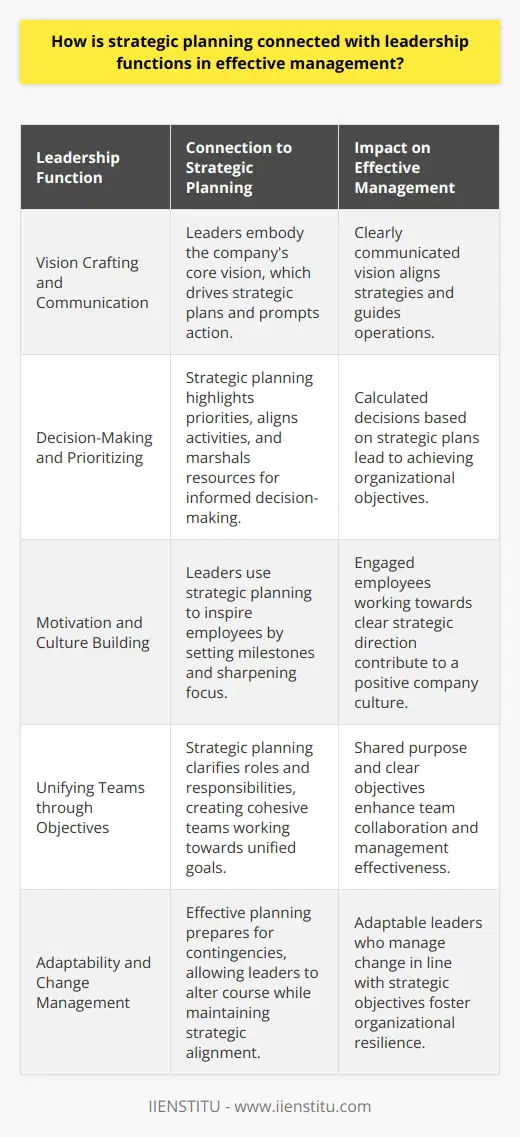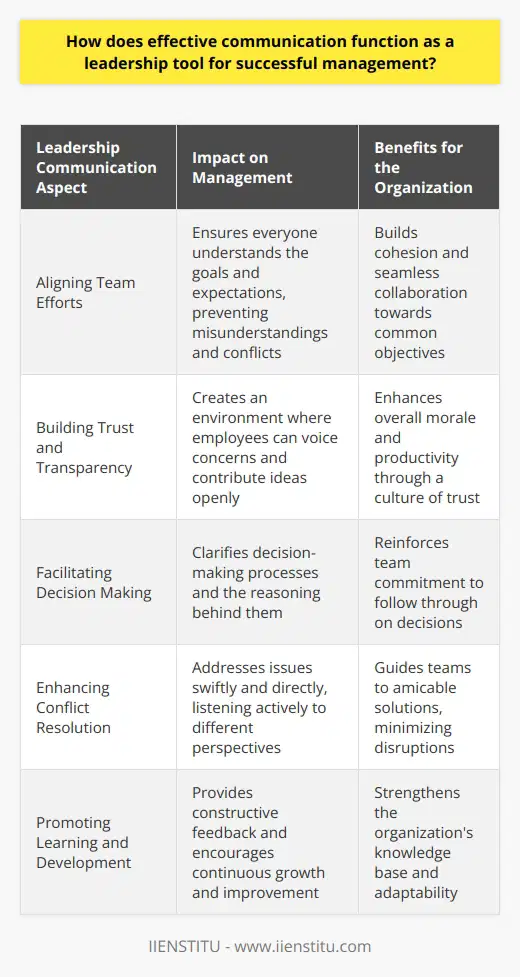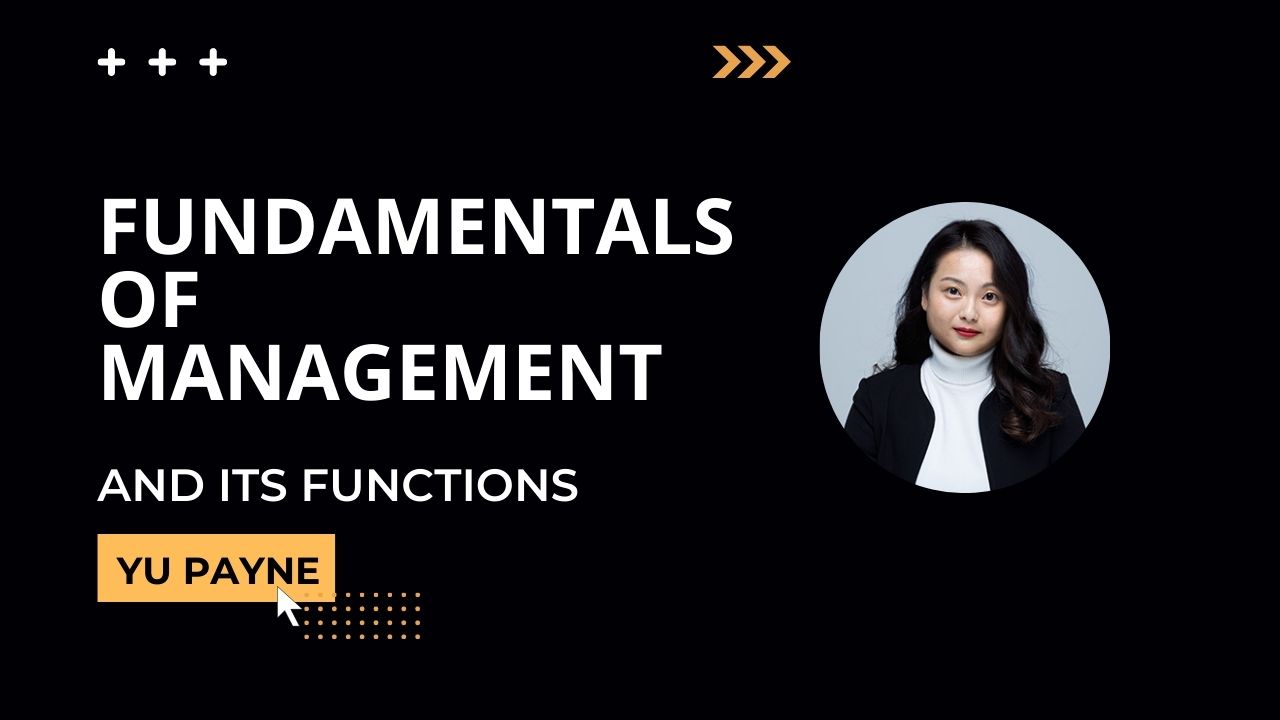
In the ever-evolving business landscape, the interplay between leadership and management is more crucial than ever. With complexities in markets and organizational dynamics, the role of leadership proves to be the cornerstone in steering the management machinery towards success.
This blog post sets out to delve deep into the symbiosis of leadership functions and effective management, elucidating the quintessential leadership roles that underpin robust management strategies. The exploration will be through a lens that appreciates the nuanced relationship of these two facets of modern business administration, aiming to shed light on how leaders can harness their skills to uplift, inspire, and guide their respective organizations.
Understanding Leadership and Management in a Business Context
Definition of leadership and management: Leadership, in a business context, is often seen as the exertion of influence and vision to direct a group or organization towards set goals. It involves inspiring others, fostering a positive environment, and setting a strategic direction. Management, on the other hand, typically refers to the process of dealing with or controlling things or people - it is the organization and coordination of activities to achieve defined objectives. Distinctly, management is more associated with planning, budgeting, and the procedural aspects of an organization.
Interconnection between leadership functions and effective management: Effective management is not possible without strong leadership functions - the two are inherently intertwined. Leaders ignite the passion that spurs employees to action, offering a beacon of inspiration that guides managerial tasks. On the flip side, management skills provide the structure and systems required for leadership visions to be successfully realized. This symbiotic relationship ensures that organizations can operate optimally, addressing both the measurable and immeasurable aspects of business operations.
Rationale behind focusing on leadership for management advancement: Focusing on leadership allows for a forward momentum in management that is often missing in overly procedural and transactional approaches. By developing leadership functions within managers, businesses can foster a proclivity for innovation, adaptable strategy formulation, and a more engaged workforce. Moreover, the modern MBA online programs and online certification courses often emphasize leadership development as a core part of their curriculum, underlining the importance that academia places on leadership in contemporary management practices.
Essential Leadership Functions for Effective Management
Strategic Vision and Goal Setting: Leadership is synonymous with setting a strategic vision; leaders have the compelling task of painting a picture of the future that others want to bring into reality. A leader's effectiveness pivots on their capacity to articulate a clear and achievable vision, one that galvanizes the entire organization into cohesive action. Effective management hinges upon these clearly delineated goals and the strategic pathways developed to reach them.
The role leaders play in defining business objectives cannot be overstated. They serve as the architects of a company's strategic blueprint, balancing the competing interests and ensuring that every segment of the organization is aligned towards the same overarching purpose.
An example of successful strategic vision in business is Steve Jobs’ reinvention of Apple with a focus on design and innovation. Under his leadership, the company successfully introduced groundbreaking products that transformed entire industries, largely because of his clear vision and profound understanding of consumer desires.
Decision-Making and Problem-Solving: At the core of leadership is the requirement to make decisions—often under pressure and with incomplete information. These decisions, ranging from operational to strategic, have profound implications on an organization's trajectory. Good leaders must, therefore, be adept problem-solvers, able to dissect complex issues and come up with solutions that align with the organization's values and strategic objectives.
Approaches to problem-solving in leadership are diverse, ranging from collaborative ideation to analytical decision-making. The modern leader seeks to involve a wider team in problem-solving, enriching the decision-making process with multiple perspectives and expertise.
The real-world implications of leadership decisions underscore the gravity of the role leaders play. Their decisions can affect everything from company culture and employee morale to financial stability and market positioning. When decisions are made with a strategic foresight and ethical consideration, leaders can drive their businesses to prosper in competitive environments.
Motivation and Employee Engagement: As gatekeepers of organizational culture, leaders have a profound impact on what motivates employees and how engaged they are with their work. Techniques like acknowledging accomplishments, providing meaningful feedback, and aligning individual values with organizational goals are just some ways leaders can inspire their teams.
The influence of robust leadership on employee engagement is palpable. Engaged employees are not only more productive and committed, but they also contribute to a positive work environment that encourages others to perform at their best.
Among countless examples of motivational leaders in business is Sir Richard Branson of Virgin Group, known for his employee-first approach. His philosophy that happy employees lead to happy customers has been the bedrock of Virgin's vibrant corporate culture and ongoing commercial success.
Development and Implementation of Effective Management Techniques
Training and Skill Development: Continuous learning and skill development are areas where leadership has a tremendous impact. Leaders not only need to embody a culture of growth within themselves but also need to instill this in their teams. They do this by advocating for a robust training framework within the organization, encouraging participation in online certification courses and ensuring that knowledge sharing is a valued part of the organizational culture. Creating a culture of development within the organization falls squarely on the shoulders of its leaders. By positioning themselves as role models for personal and professional development, leaders can influence their teams to seek out growth opportunities—be it through traditional educational avenues such as an MBA online or through hands-on work experiences.
Adaptability and Change Management: In a world of rapid technological changes and shifting market demands, adaptability has become a cornerstone of successful business. Leaders are at the helm of this adaptability, guiding their organizations through the uncharted waters of the external business environment. Leadership approaches to successful change management include clear communication, stakeholder engagement, and resilience-building within the team. Leaders must not merely manage change but champion it, showcasing their own adaptability as a testament to the organization's ability to thrive amidst transformation.
In conclusion, the essence of leadership functions for effective management can be encapsulated in the vision setting, decision making, and the motivation and engagement of employees. These roles foster a progressive and adaptable environment necessary for contemporary business success. Throughout this article, we have seen how leadership extends beyond individual charisma to embed itself as the lifeblood of organizational performance.
Leaders who continually develop their skills create resilient businesses capable of navigating the complexities of a rapidly evolving marketplace. For those eager to enhance their management practices, embracing the nuanced aspects of leadership functions is not merely advisable; it is indispensable.
Frequently Asked Questions
What are the key leadership functions that are critical for effective management?
Understanding Leadership Functions
Effective management stems from the execution of key leadership functions. Leaders must understand these to excel. Their teams depend on these abilities. Here's how leaders can drive success.
Setting Clear Objectives
Leaders must define goals. Clear targets focus effort. Team members thrive on direction. Specific objectives guide daily actions.
Developing Strategies
Leaders plan for success. This involves constructing achievable roadmaps. Strategies break down complex objectives. They guide teams to outcomes. Strategic thinking is vital here.
Inspiring and Motivating
Inspiration fuels the workforce. Leaders use charisma and vision. They foster a can-do attitude. Morale stays high as a result. Motivation is a continuous process.
Communicating Effectively
Communication is the cornerstone. Leaders must relay information clearly. Feedback loops are indispensable. They ensure understanding and alignment. Effective communication drives efficiency.
Building a Positive Culture
Culture impacts performance. Leaders shape this culture. They instill values and behaviors. A positive culture attracts talent. It also promotes retention.
Making Decisions
Decisions set directions. Leaders face tough choices. They use data and intuition. Quick, informed decision-making is essential. This keeps the organization agile.
Delegating Responsibilities
Delegation is a skill. Leaders empower others. They entrust tasks appropriately. This increases efficiency and develops staff. Teams become more autonomous over time.
Managing Performance
Performance needs monitoring. Leaders track and measure outcomes. They provide constructive feedback. This ensures accountability. It helps meet and exceed standards.
Encouraging Innovation
Innovation keeps companies relevant. Leaders encourage creative thinking. They reward initiative and ideas. Innovation drives growth. It differentiates from competitors.
Leading Change
Change is inevitable. Leaders guide teams through transitions. They anticipate and manage resistance. Adaptability is a critical trait here.
Understanding these functions helps leaders manage better. They improve over time with practice. Meanwhile, they uplift their organizations. No single approach fits all. But these functions act as a foundation. They support other bespoke strategies. Together, they forge effective management and successful outcomes.

How is strategic planning connected with leadership functions in effective management?
Strategic Planning: Management's Backbone
Effective management thrives on robust strategic planning. This process defines organizational direction. It reveals paths to objectives and goals. Leadership functions intertwine here, anchoring in strategy.
Vision Crafting and Communication
Leaders paint the company's future. They embody its core vision. This drives strategic plans. Effective leaders must communicate this vision clearly. Their words prompt action. They spawn the strategies that guide operations.
Decision-Making and Prioritizing
Leaders face choices daily. Strategic planning aids them. It highlights priorities, aligns activities, and marshals resources. Decisions, thus, are not random. They are calculated steps towards a grand plan.
Motivation and Culture Building
Strategic planning molds company culture. Leaders use it as a tool. They inspire, setting strategic milestones. Employees engage when direction is clear. Leaders leveraging strategy sharpen this focus.
Unifying Teams through Objectives
Teams with a Shared Purpose
Leaders create cohesive teams via planning. Each member understands their role. They work towards unified strategic goals. Planning makes roles and responsibilities clear within management.
Accountability through Milestones
Leaders track progress through milestones. These are steps in strategic plans. Accountability arises when teams reach these milestones. Strategic planning thus becomes a measure of leadership efficacy.
Adaptability and Change Management
Leaders must also be adaptable. Effective planning prepares for contingencies. Leaders can alter course. They maintain alignment with strategic objectives. Change is not feared but managed.
Continuous Improvement and Innovation
Assessing and Re-strategizing
Strategic planning is not static. Leaders constantly assess and adapt plans. They seek improvement. They strive for innovation within the strategic framework. Flexibility here begets resilience.
Learning and Leadership Development
Strategic planning is a learning tool. Leaders gain insights and develop skills. They analyze outcomes and refine strategies. This iterative process is key. It defines leadership growth in managing effectively.
In sum, strategic planning is essential. It guides leaders in managing effectively. It connects vision with action. It prioritizes, motivates, unifies, and improves. Leadership without strategic planning lacks direction. To lead is to plan. To manage effectively is to execute that plan.

How does effective communication function as a leadership tool for successful management?
Effective Communication in Leadership
Key to Management Success
Leadership thrives on clear communication. It conveys vision, aligns teams, and fosters trust. Managers who communicate effectively drive organizational goals. They motivate and build strong relationships. In essence, communication is an indispensable management tool.
Aligns Team Efforts
Effective communication ensures everyone understands the goals. Leaders guide teams with clarity. They set clear expectations, avoiding misunderstanding. This alignment prevents conflict and builds cohesion. Teams thus work towards common objectives seamlessly.
Builds Trust and Transparency
Open dialogue between leaders and teams builds trust. Authentic communication fosters a transparent environment. It enables employees to voice concerns and contribute ideas. A culture of trust enhances overall morale and productivity.
Facilitates Decision Making
Leadership involves decision-making processes. Effective communication clarifies these processes for team members. It ensures everyone knows the 'why' behind decisions. This understanding reinforces team commitment to follow through.
Enhances Conflict Resolution
Conflicts are inevitable in any workplace. Effective communication is crucial for resolution. Leaders address issues swiftly and directly. They listen actively to different perspectives. Through this, they guide teams to amicable solutions.
Promotes Learning and Development
Good leaders value continuous learning. They communicate feedback constructively. They encourage teams to grow and improve. This ongoing development strengthens the organization's knowledge base.
Ensures Adaptability and Change Management
Organizations face constant change. Leaders using effective communication facilitate smooth transitions. They explain new initiatives well. They help teams adapt quickly. Thus, they ensure change does not impede productivity.
Emphasizes Recognition and Rewards
Effective communicators acknowledge accomplishments. They celebrate team achievements openly. Recognition motivates employees. It shows appreciation and encourages continued excellence.
In essence, communication is a powerful tool for successful management. It aligns teams, builds trust, and steers organizations through change. Leaders must hone their communication skills to drive success and foster a positive, productive work environment.



